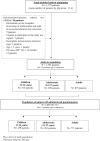Cross-sectional study to describe allergic rhinitis flare-ups and associated airways phenotype in house dust mite sensitization
- PMID: 36952530
- PMCID: PMC10035855
- DOI: 10.1371/journal.pone.0283246
Cross-sectional study to describe allergic rhinitis flare-ups and associated airways phenotype in house dust mite sensitization
Abstract
Objectives: To quantify and describe flare-ups of house dust mite allergic rhinitis (HDM-AR) which had occurred during the last 12 months in a population of adults and children candidate for Allergen ImmunoTherapy (AIT). Next, to identify associated clinical features.
Materials and methods: This was an observational, multicenter, cross-sectional study that included patients aged ≥ 5 years with HDM-AR eligible for AIT and without prior AIT for at least 12 months. Flare-ups were all period with impairment of quality of life (QoL) and requiring a change in their usual treatment. Data were collected using medical records and patient questionnaires. Variables associated with the occurrence of ≥ 2 AR flare-ups were identified.
Results: 1,701 patients were included (average age: 23 years, 51.5% males, 30.4% children, 17.7% adolescents and 51.9% adults). Severe and persistent AR affected 70.9% of them and 53.7% showed polysensitization. Asthma was associated with AR in 34.4% and was well-controlled in 58.5%. The occurrence of at least one AR flare-up in the year was reported by 77.7%, with an annual rate in the whole population of 2.6 ± 3.9 and a duration of 14.1 ± 17.1 days. Deeply or moderately AR-related degraded QoL was experienced by 39.5% and 64.6%, respectively. The occurrence of ≥ 2 AR flare-ups was reported by 54.5% and was associated with polysensitization, AR intermittence and severity.
Conclusion: AR flare-ups are frequent and impair QoL in HDM-allergic patients, suggesting that it could be considered as therapeutic targets.
Copyright: © 2023 de Gabory et al. This is an open access article distributed under the terms of the Creative Commons Attribution License, which permits unrestricted use, distribution, and reproduction in any medium, provided the original author and source are credited.
Conflict of interest statement
Ludovic de Gabory: Honoraria/Consulting: ALK-SAS, AstraZeneca, Chiesi, GlaxoSmithKline, Integra Life Science, Laboratoire de la Mer, Laboratoire Chemineau, Medtronic, Sanofi Genzyme, Zambon. Sabine Amet: ALK SAS corporate employee Annelore Le Maux: ALK SAS corporate employee Jean-Pierre Meunier: Manager of the CRO Axonal, which was designated by ALK to conduct the trial Antoine Chartier: ALK SAS corporate employee Cécile Chenivesse: Grants from AstraZeneca, Santelys Personal fees from ALK SAS, AstraZeneca, Boehringer Ingelheim, Chiesi, GlaxoSmithKline, Novartis, Sanofi-Regeneron, TEVA Congress support from ALK SAS, AstraZeneca, Boehringer Ingelheim, GlaxoSmithKlein, Novartis, Pierre Fabre, Pfizer, Roche, TEVA
Figures
References
-
- Gayraud J, Refabert L, Chartier A. Influence of asthma on specific immunotherapy practices in patients with house dust mite-induced allergy. An observational study AdArA. Rev Fr Allergol. 2013. Sep;53(5):458–467. 10.1016/j.reval.2013.07.003. - DOI
Publication types
MeSH terms
Substances
LinkOut - more resources
Full Text Sources
Research Materials



